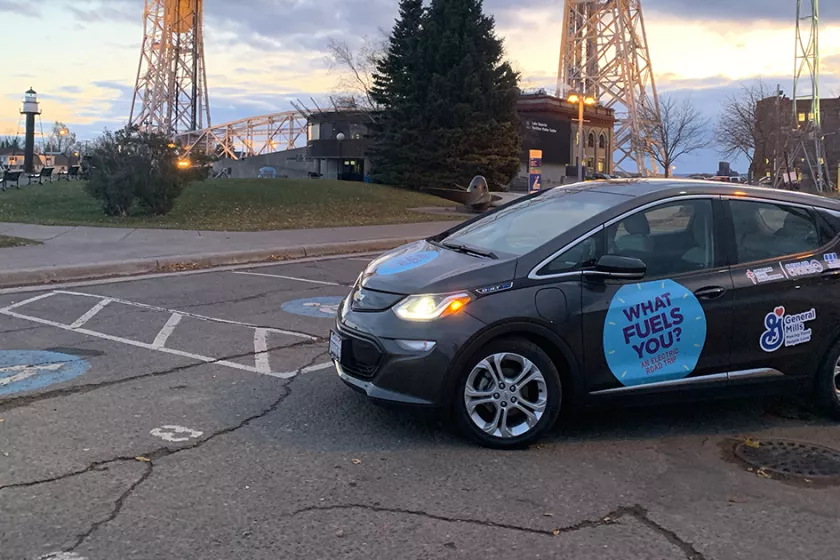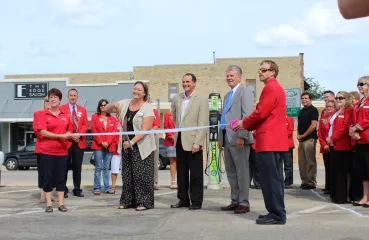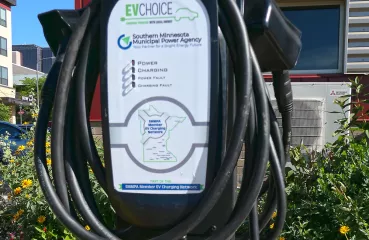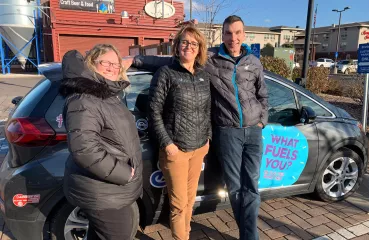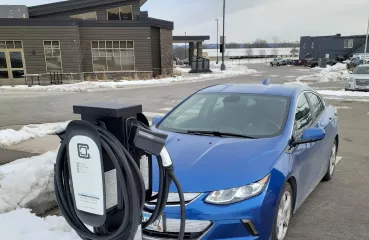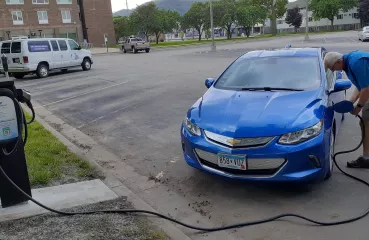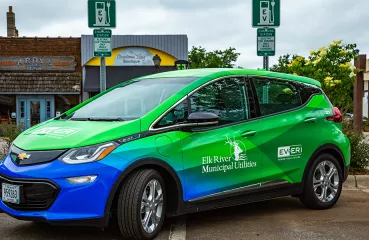Colby Abazs: Yusef, can you start by telling us a little bit about your role at Minnesota Power and what your interest is in transportation?
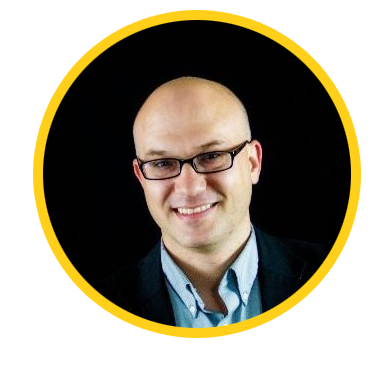 Yusef Orest: At Minnesota Power I serve as the electric vehicle (EV) programs and services representative. We’re involved in EV charging rates for residential customers and commercial services. We help customers think about how they might utilize an EV and how they’re going to charge it. We work with commercial entities to help scope electrification projects, like if they say ‘we want to do electric forklifts’ or ‘we want to add an electric vehicle to our fleet’. Effectively we’re the go-to resource for consumers who want or need information on the process of electrifying their transportation or equipment.
Yusef Orest: At Minnesota Power I serve as the electric vehicle (EV) programs and services representative. We’re involved in EV charging rates for residential customers and commercial services. We help customers think about how they might utilize an EV and how they’re going to charge it. We work with commercial entities to help scope electrification projects, like if they say ‘we want to do electric forklifts’ or ‘we want to add an electric vehicle to our fleet’. Effectively we’re the go-to resource for consumers who want or need information on the process of electrifying their transportation or equipment.
I’m also personally interested in transportation. I’m a car person—it’s in my bones. And I think it’s in the bones of Americans as well. We have a love affair with automobiles in this country. Presently, our life here is built on individualized transportation, but I see that changing in the future. Because of that zest for automobiles that we have, there is a sincere opportunity on two fronts.
The first is the cost of ownership and equitable access to transportation. EVs represent a lower cost of ownership both from operations and with a price point that’s plummeting. This means that drivers of all stripes will be able to get into an EV and reduce their total cost of ownership and hopefully this increases mobility options for lots of consumers. I also think that there are going to be some pretty excellent opportunities for vehicle sharing in the future that could make vehicles accessible to all.
Second, there’s a huge trend in the utility sector to reduce greenhouse gas emissions. There’s been a lot of success in that realm. And as part of the utility sector, we’re now preparing to help repeat those successes in the transportation sector. We’re ready to support how those activities actually happen. Along with that, every major auto manufacturer has made an announcement about electrifying transportation. This is really where greenhouse gas reductions matter the most right now—decreasing those emissions from transportation. I would encourage you or anyone else to check out the Minnesota Pollution Control Agency’s website about greenhouse gas emissions. They have some pretty intuitive dashboards there and they show the trends. Transportation still has plenty of work to do. The electric utility sector does too, but we’re all working in the same direction.
Colby Abazs: There’s really been a dramatic shift from all of the automobile manufacturers, both for personal vehicles and public transit vehicles toward EVs. It’s exciting that Minnesota Power is getting on the forefront of that to try to be ready for that as a utility. Also exciting is the utility’s focus on renewables. How much of Minnesota Power’s electricity generation is from low-carbon sources?
Yusef Orest: We announced late last year in 2020 that we hit a pretty major milestone. 50% of our generation we provide comes from renewable sources. That’s a big milestone not only for the state but also for the country. That’s a huge achievement and we’re very proud of that here. Related to our conversation today, we also announced that we intend to have our transportation fleet be 50% electric or carbon neutral by 2030, so that’s a pretty aggressive goal also. We’ve got a track record of putting our best foot forward and hitting those goals, so we’re pretty excited to keep doing that.
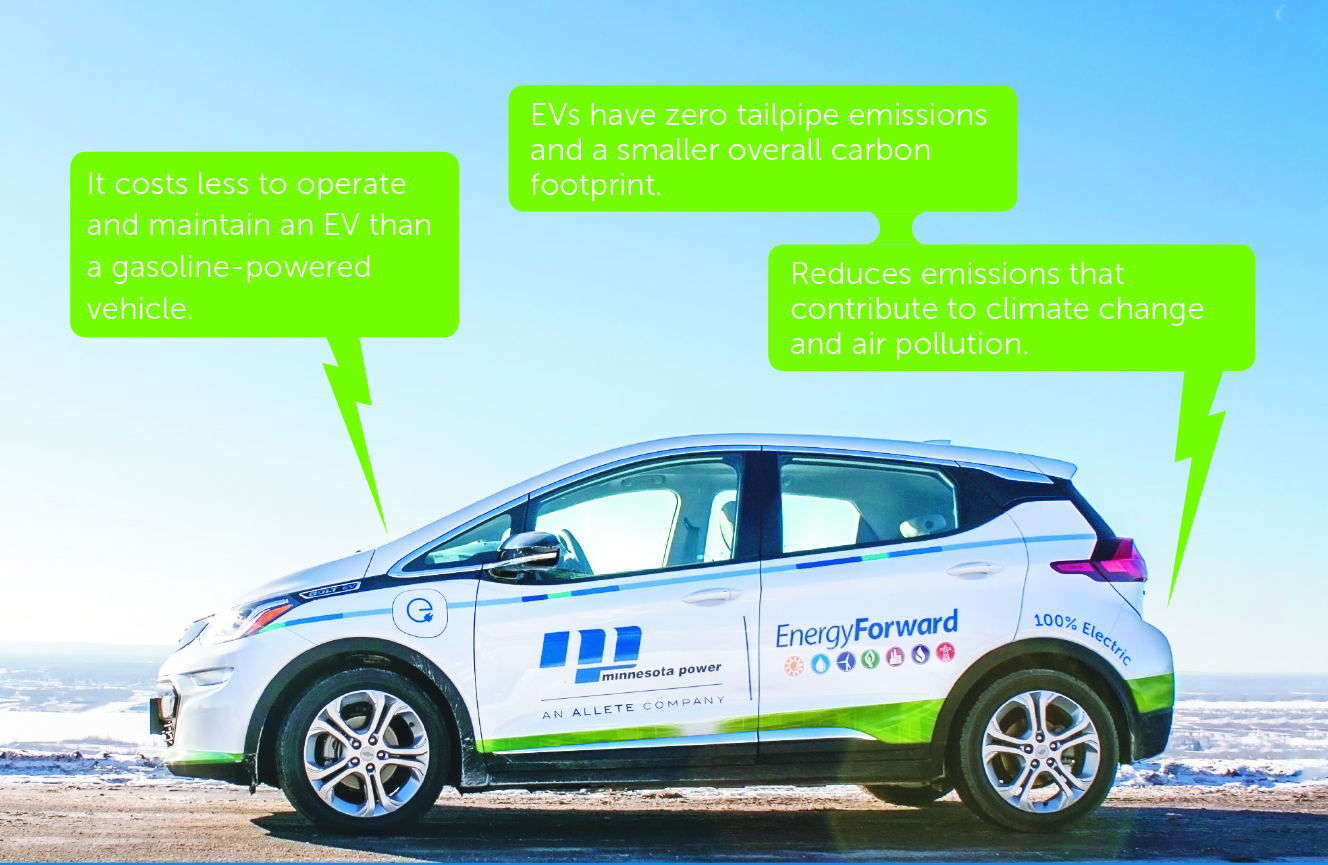
Colby Abazs: I know you have a couple EVs in your fleet right now. You also mentioned that you help customers with their fleets, like if someone wants to add an electric forklift. Is that assistance part of your role as well?
Yusef Orest: Yes. Minnesota Power is a pretty cross-functional place. We have a lot of knowledge inside of our organization and we try to share in between teams. So I serve on several committees where we try to do that knowledge transfer to teams working on different projects. Talking about mine truck electrification is one, we have a couple of news clips out there about that. Things like forklifts, I brought that up already. Forklifts are a great example of an electrification project for all sorts of organizations. Minnesota Power does have some EVs in its fleet today, those are passenger vehicles. We’re also working on the next level of how we can electrify more of our vehicles. But there’s everything from electric skid steers today to electric lawnmowers, snowblowers, snow brooms, forestry equipment. It’s an explosion of possibilities when it comes to electrifying equipment.
Colby Abazs: That’s impressive, and nice to hear that heavy equipment options exist, too, with their power needs. Above and beyond the environmental benefits, for the workers it’s the sound, the exhaust.
Yusef Orest: There are several benefits, and I’m glad you brought that up. Cost is frequently the top one that people talk about, and then environmental benefits. But there’s operational parameters, there’s noise, there’s air pollution in confined spaces where people are working or operating, there’s the maintenance components of how you operate some of this equipment. Maintenance is drastically reduced with this electric equipment, they don’t need oil changes.
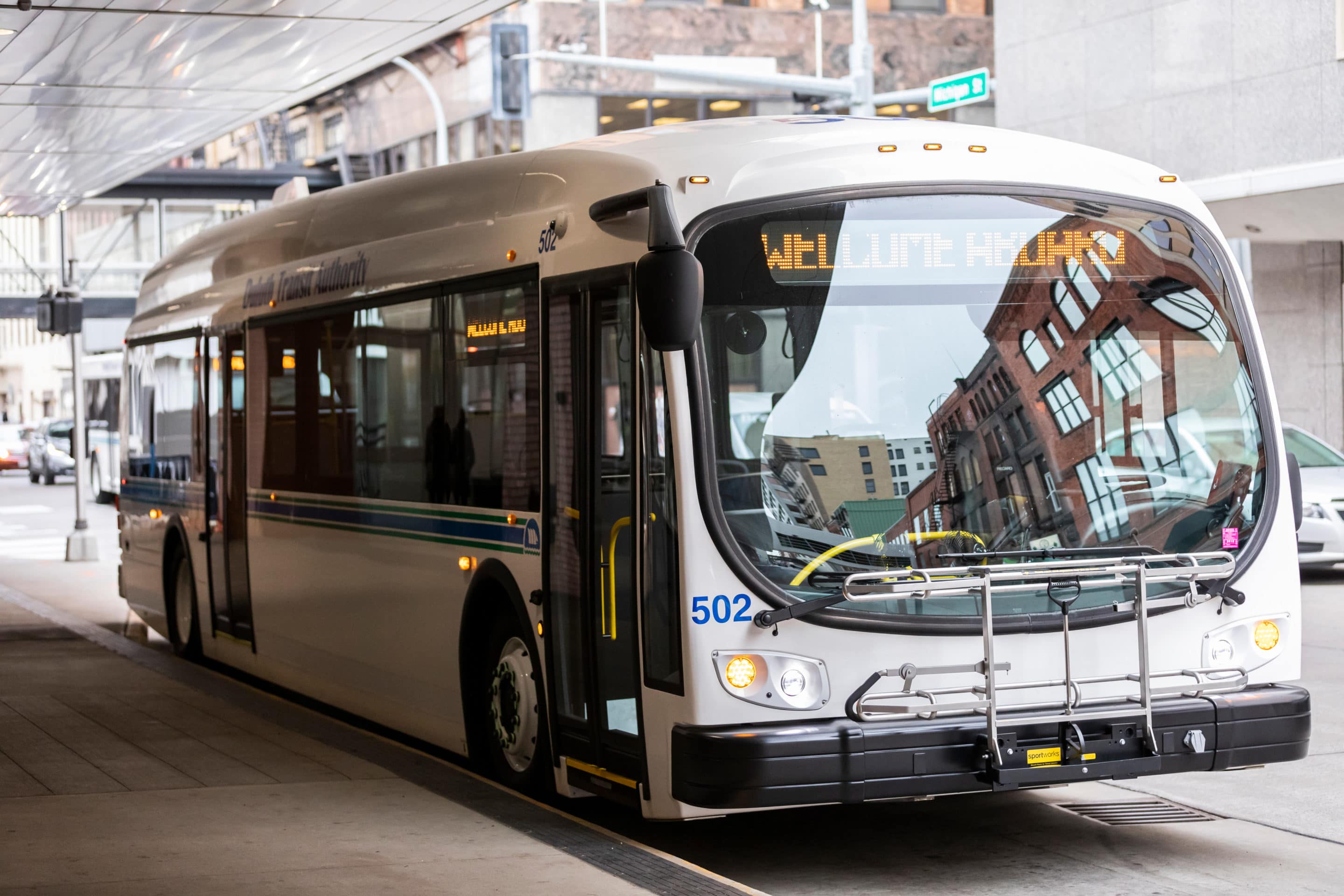
One of Duluth Transit Authority's electric buses takes to the streets.
Colby Abazs: Today I’m also excited to talk about public, mass transit, which we don’t have a lot of because we’re pretty rural up here in Northeast Minnesota. Is there anything exciting that Minnesota Power has been involved with lately with regards to public transit, EVs or other low-carbon options?
Yusef Orest: There are a lot of things afoot. The Duluth Transit Authority operates some electric buses. That’s a pretty exciting opportunity that exists out there and they have had some successes with that.
May Mobility is talking about kicking off a project in our region as one of several pilots across the country. That’s an autonomous vehicle on an electric platform.
We have a really big regional transportation provider known as Arrowhead Transit. They’re one of the top five rural transportation providers in the country as far as I know. And they’ve been doing some investigations around electric vehicles.
I’ve talked to several cities and counties with fleets that are all looking at electrification of their vehicles. Everyone’s waiting for the electric pickup truck to come along—that’s going to be a real gamechanger.
I’ve talked to a regional development commission considering something like an HOURCAR scenario where people can rent an EV as a mobility option for short durations of time.
And then there are countless commercial fleets that we’re having conversations with about how they might add an electric garbage truck to their ranks, or how they can have an electric vehicle working in the yard for a trucking organization, or even longer range trucking. We’re starting to see announcements from heavy vehicle manufacturers about electric drivetrains for over-the-road trucks and long-range electric buses. There’s a lot of activity happening in the transportation space right now.
Colby Abazs: You mentioned garbage trucks. Just think if you don’t have to get woken up early in the morning when that noisy garbage truck is making its rounds.
Yusef Orest: Yes, and one of the big things about vehicles like garbage trucks is the air pollution that they leave in their wake as they slowly make their way through neighborhoods, that can be a pretty significant health factor for communities that are denser, and that matters. I encourage people to do that research on that. In fact, the Minnesota Pollution Control Agency has an environmental equity map that covers some factors like that. It’s important to have those conversations.
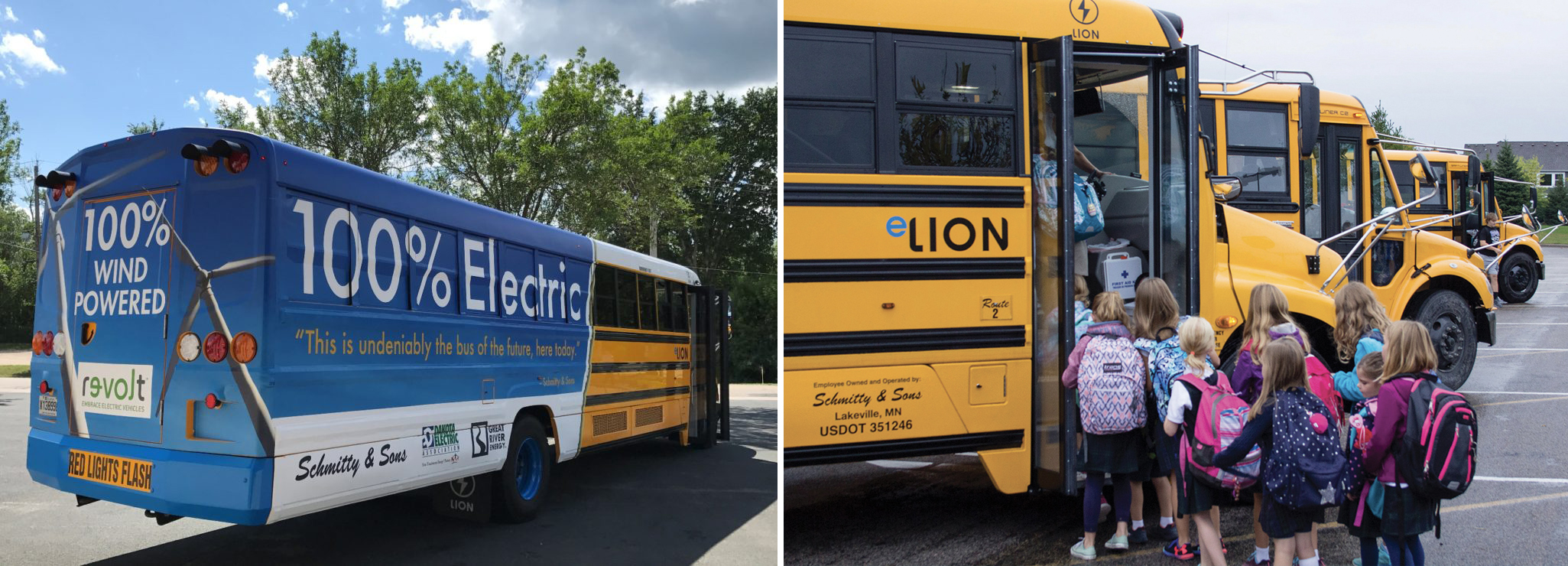
Dakota Electric Association and Great River Energy partnered with Schmitty & Sons to bring the first electric school bus to a Minnesota school district. (Photo courtesy Dakota Electric Association).
Colby Abazs: I know there has been a lot of talk lately nationally about school buses. Obviously they’re around our kids, and so we don’t want a lot of pollution there. Is there anything you’re seeing on the horizon from school buses, and has there been any interest in the region for making the shift to electric school buses?
Yusef Orest: Yes. Actually in February of 2020 before COVID started, there was a demo in Duluth held by a major school bus manufacturer and I got to ride on an electric school bus. That was pretty impressive. Minnesota Pollution Control Agency administers the Volkswagen Settlement funds, and part of those funds were earmarked for electrification of school buses.
I did talk to a few organizations who were interested in getting a bus. I think that we’ll see more of that. With any technology shift, when we start adding a new electric drivetrain to the mix for fleet operators, there’s always the first to-market problem. That’s what these pilot programs are all about. It’s nice the we have some of these funds coming to the state so that we can bear out some of these models and figure out what works and what doesn’t. I think there are a lot of schools who would bump up the priority of having an electric school bus, either for a regular route or for regional transportation as the market continues to grow and we learn more about how it works to operate an electric school bus in both urban and rural settings.
Colby Abazs: And I’m sure it would take some time to shift fleets over. I know that some schools are using buses that have been around for a while, or source used vehicles. That could be a long transition to make that shift, we just have to get the ball rolling.
Yusef Orest: Schools are all very savvy and sensitive to how much operating capital they have, so they do tend to operate buses for as long as they can. Whether it’s a school bus or a private transportation bus, there’s a limit of life on some of those things. In some of these investigations I’ve seen that while today electric transportation options are two to three times the cost, once you factor in the fuel cost savings, they get a lot closer to parity with what’s available on the market today. We’re really close.
Colby Abazs: Are you seeing anything encouraging that you think will increase the adoption of electric vehicles in rural areas?
Yusef Orest: The pace of technological advancement in this space—the battery life and drivetrain efficiencies, all of the new startups that are coming in with new models and derivations—is making these projects more possible than ever. My viewshed of the market is that over the next one to three years it’s really all about proof in practice. Us humans, we aren’t believers until we see something in action. Combine these improvements with things like route-matching capabilities, charging networks for regional transportation, all of that is improving. We’re going to see a huge influx of investment in the state. A lot of that is coming from Volkswagen funding, but utilities are also looking at how they can play a role in those investments and that we have a minimal viable network to support not just passenger vehicles, but also transportation for public and commercial service. With all of this coming together we’re going to have this nexus that makes things more possible.
Colby Abazs: I imagine that opens up more potential and possibilities, too. Say if a school bus fleet is planning to switch over to electric and then maybe the parking lot or garage where they store the buses and will likely be charging them is a great place to put a bunch of solar panels. Then they get that demand and supply right next to each other.
Yusef Orest: That’s a good point. There’s a public EV charging station in Duluth's Canal Park that has solar on site, and there are a couple others, one in Motley and one in Virginia, that are both solar and EV charging co-located. There are definitely some benefits of that. The Great Plains Institute has been doing some research around that co-benefit, and all of this information is emerging at a rapid pace. Again, I really feel like a lot of things are going to come together in the next 12-36 months. It’s an exciting time.
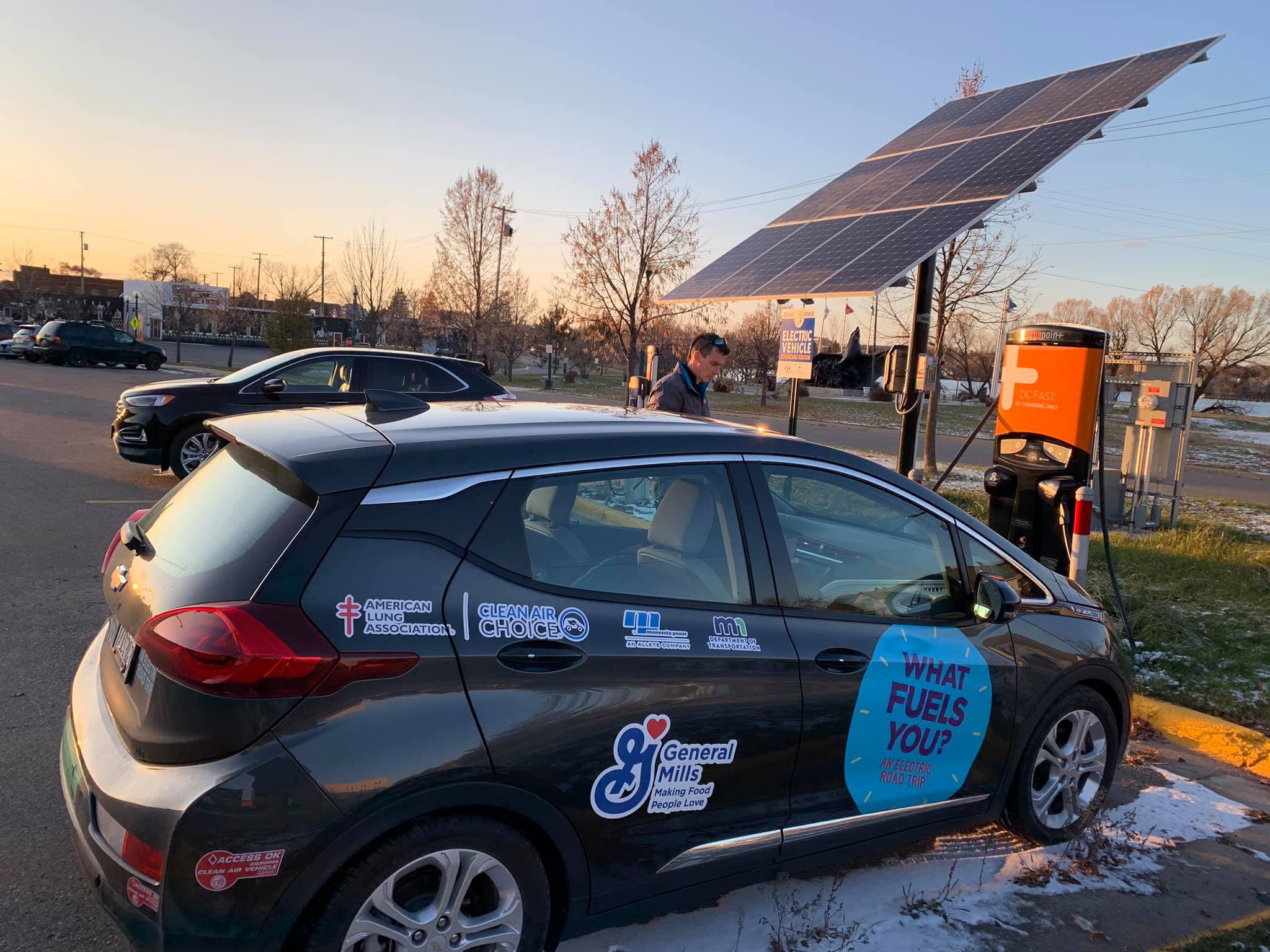
The "What Fuels You?" EV roadtrip crew charges up in Virginia, MN.
Colby Abazs: Before you mentioned the HOURCAR model. That seems like it would be a great way for someone to be able to test out an EV and have an experience to see if they like it. Having those short-term or weekend rentals could be a good way to stick their toe in the door.
Yusef Orest: Dealerships are starting to grow in their stock of EVs in our region. There are only a few presently, but again I think that in 12-36 months we’re going to see a pretty rapid shift on that. So that’s one way that people can experience the cars. There will be opportunities to rent an EV or take one for the weekend from a traditional car rental place. Minnesota Power also hopes to be able to get back out into the field and do some ride and drive events and other educational opportunities for people. We’ve obviously been restricted due to COVID, but at some point we’ll be able to get back together in a parking lot and have a conversation about these vehicles with people.
Colby Abazs: You know what they say, if you can get a butt in a seat then you have a new EV driver. I’m not in the market for a new car right now, but I know that my next one will be an EV. I know that Drive Electric MN has a lot of resources for people thinking about going electric.
Yusef Orest: For those who don’t know, there are essentially three types of electric vehicles. First, there’s a traditional hybrid. A Toyota Prius is a great example of that. It has a gas and electric powertrain. Second, you move up a step and have a plug-in electric hybrid vehicle. That has the gas and electric drivetrain, but it has some all-electric range. You can plug in at a wall outlet or charging station and maximize that electric drivetrain usage. Third, the last step is a purely electric vehicle like a Chevy Bolt, the new Mustang Mach-E, Nissan Leaf, Tesla. Those are all battery electric vehicles.
If people aren’t ready to take the plunge on a fully electric vehicle, the options for hybrid electric vehicles are pretty robust at this point. For a lot of drivers, a plug-in electric vehicle has almost the same impact as a battery electric vehicle because they drive under 30 miles a day. They go to work, come home, drive a couple errands, and that’s most of the driving they do. There’s a wonderful selection of vehicles for people out there right now. Minnesota Power is looking forward to helping people make those decisions about what electric vehicle is right for them.
Colby Abazs: What’s your recommendation for people who want to start electrifying things in their life?
Yusef Orest: First I’d say phone a friend. Call your utility that you have service from. They probably have someone on staff with some knowledge of which direction you can go. So if you’re thinking about an electric car, that’s one way to go. And then some of the small things you can electrify include yard equipment. Two and four stroke engines, even though they have a pretty small runtime, actually make up a pretty significant source of greenhouse gas emissions in the world. You can now get electric lawnmowers, chainsaws, snowblowers. There are also electric skid steers, four wheelers, side-by-sides, even snowmobiles.
Colby Abazs: Any last words you’d like to share in closing?
Yusef Orest: Yeah, thanks. You know, as people keep trying out these products our norms will shift. Adoption can take a while, but at some point we’re going to hit an inflection point. Just like the internet or smartphones, at some point having everything be electric will just feel normal, and I’m looking forward to that day.
Editor's note: This interview contains the thoughts and opinions of Yusef Orest and not necessarily that of Minnesota Power.


.png)


 Yusef Orest: At
Yusef Orest: At 



